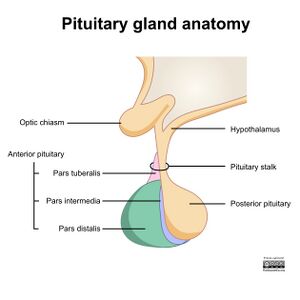Pituitary Gland
Original Editor - Lucinda hampton
Top Contributors - Lucinda hampton
Introduction[edit | edit source]
The pituitary gland is a tiny but vital organ acting as the main endocrine interface between the central nervous system and the entire body, the so called master gland. It is a pea sized organ found at the base of the brain in a bony hollow, just behind the bridge of your nose .[1][2] The hypothalamus, just above it, is part of the brain and controls the pituitary by sending it messages.[3] The anterior pituitary has blood vessels connecting it to the hypothalamus whilst the posterior pituitary has neural connections.
Divisions[edit | edit source]
Anterior pituitary: the largest part of the gland, secreting six hormones, each with a specific functions and target organs:
- Growth hormone (somatotropin)
- Thyroid stimulating hormone (TSH)
- Adrenocorticotropic hormone (ACTH)
- Follicular stimulating hormone (FSH)
- Luteinizing hormone (LH)
- Prolactin
Posterior pituitary: The posterior pituitary is connected directly to the hypothalamus via a nerve tract (hypothalamohypophyseal nerve tract). Oxytocin and antidiuretic hormones are synthesised in the hypothalamus and travel down the nerve tract to be released in the posterior pituitary.[4]
Pathology[edit | edit source]
This gland often develops pathology, which may have an effect adjacent intracranial structures or be hormonally active. Pituitary adenomas are present in 14% of autopsy studies and 23% of radiology studies.[4]
The more common pituitary conditions include:
- Hyperprolactinaemia (too much prolactin in the blood).
- Growth hormone deficiency: can delay children’s growth and lead to a child being shorter in height than expected. In adults, the symptoms of growth hormone deficiency include fatigue, weak muscles and bones, excess weight, anxiety, mood problems or sleep problems.
- Hypopituitarism: a deficiency of all the pituitary hormones and causes many different symptoms.
Uncommon pituitary conditions include:
- Gigantism — where a person grows very tall
- Acromegaly — where a person’s hands, feet and jaw enlarge
- Cushing’s syndrome — where the body creates too many steroid hormones
Sub Heading 3[edit | edit source]
Resources[edit | edit source]
- bulleted list
- x
or
- numbered list
- x
References[edit | edit source]
- ↑ Banas A, Banas K, Furgal-Borzych A, Kwiatek WM, Pawlicki B, Breese MB. The pituitary gland under infrared light–in search of a representative spectrum for homogeneous regions. Analyst. 2015;140(7):2156-63. Available:https://pubmed.ncbi.nlm.nih.gov/25574521/ (accessed 14.1.2023)
- ↑ Radiopedia Pituitary Gland Available:https://radiopaedia.org/articles/pituitary-gland (accessed 14.1.2023)
- ↑ The pituitary foundation What is the pituitary gland? Available:https://www.pituitary.org.uk/information/what-is-the-pituitary-gland/ (accessed 14.1.2023)
- ↑ 4.0 4.1 El Sayed SA, Fahmy MW, Schwartz J. Physiology, pituitary gland.Available:https://www.statpearls.com/articlelibrary/viewarticle/767/ (accessed 14.1.2023)








